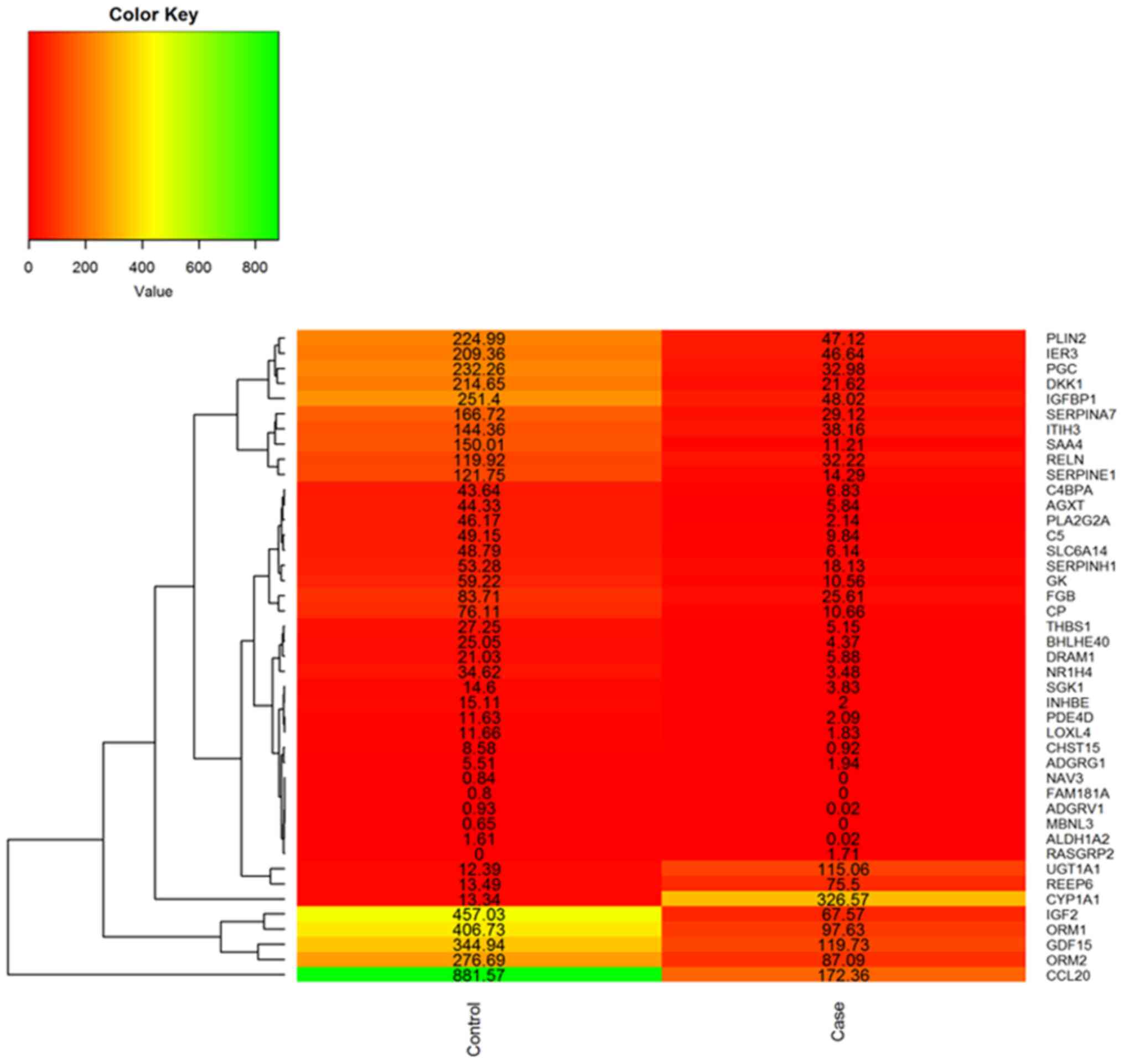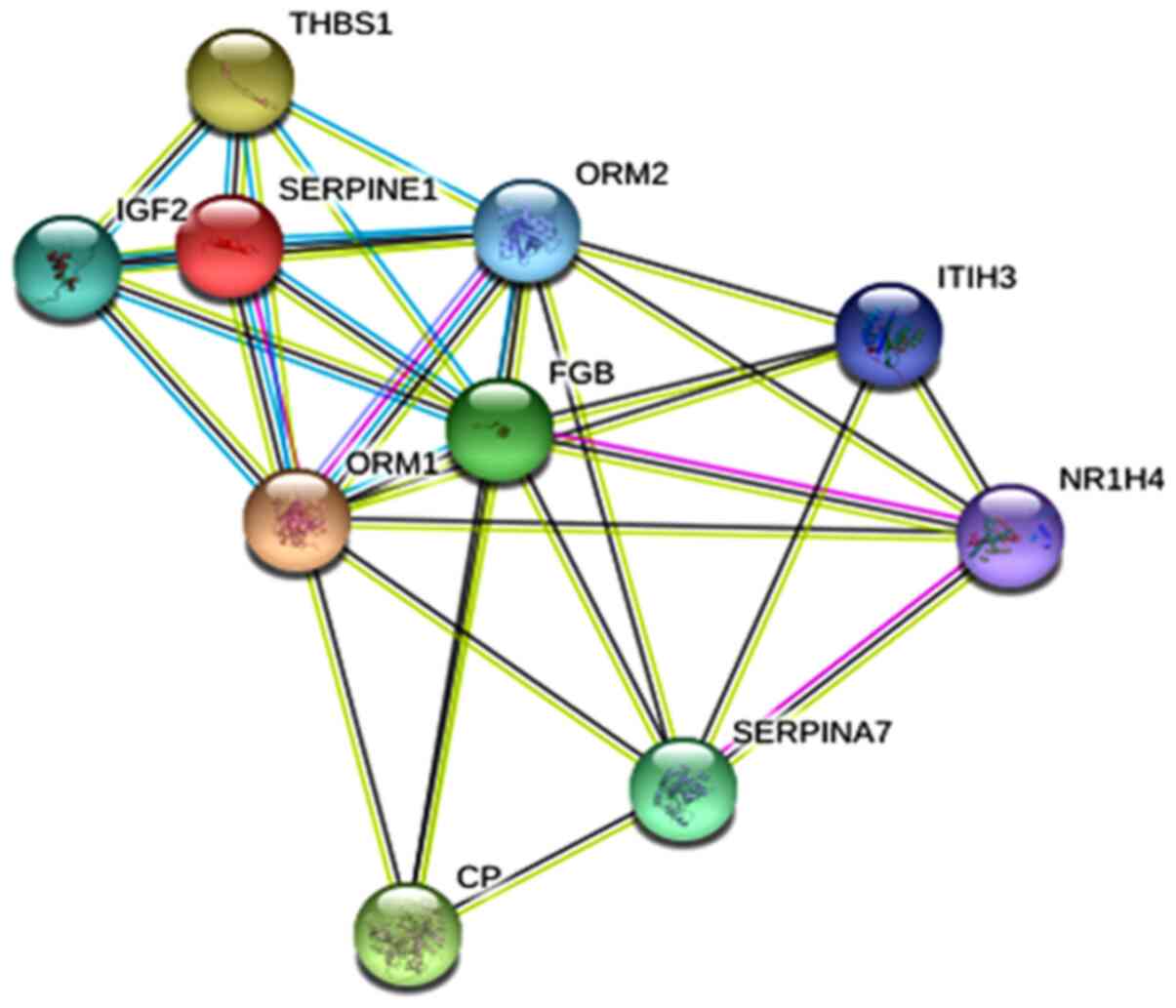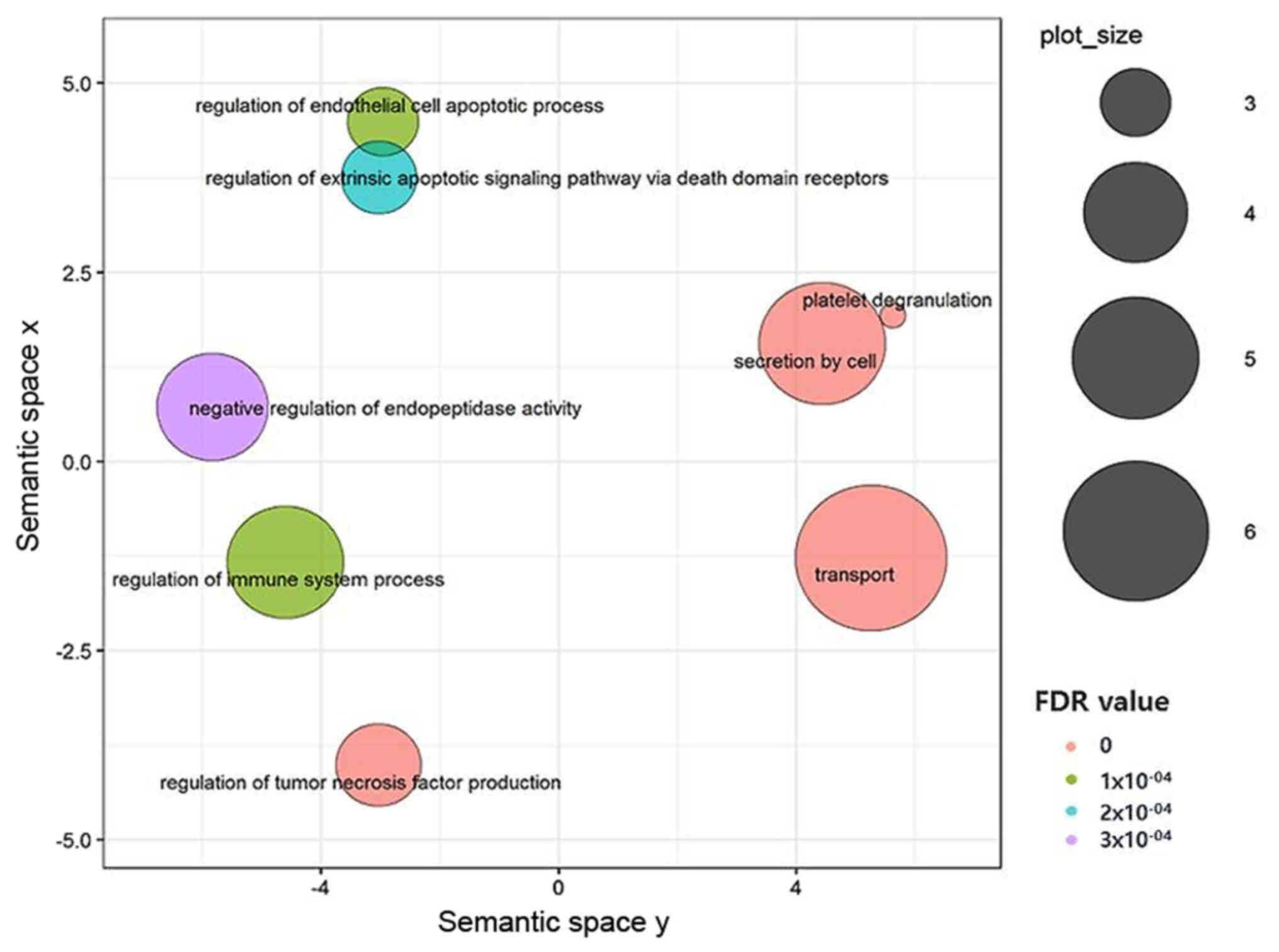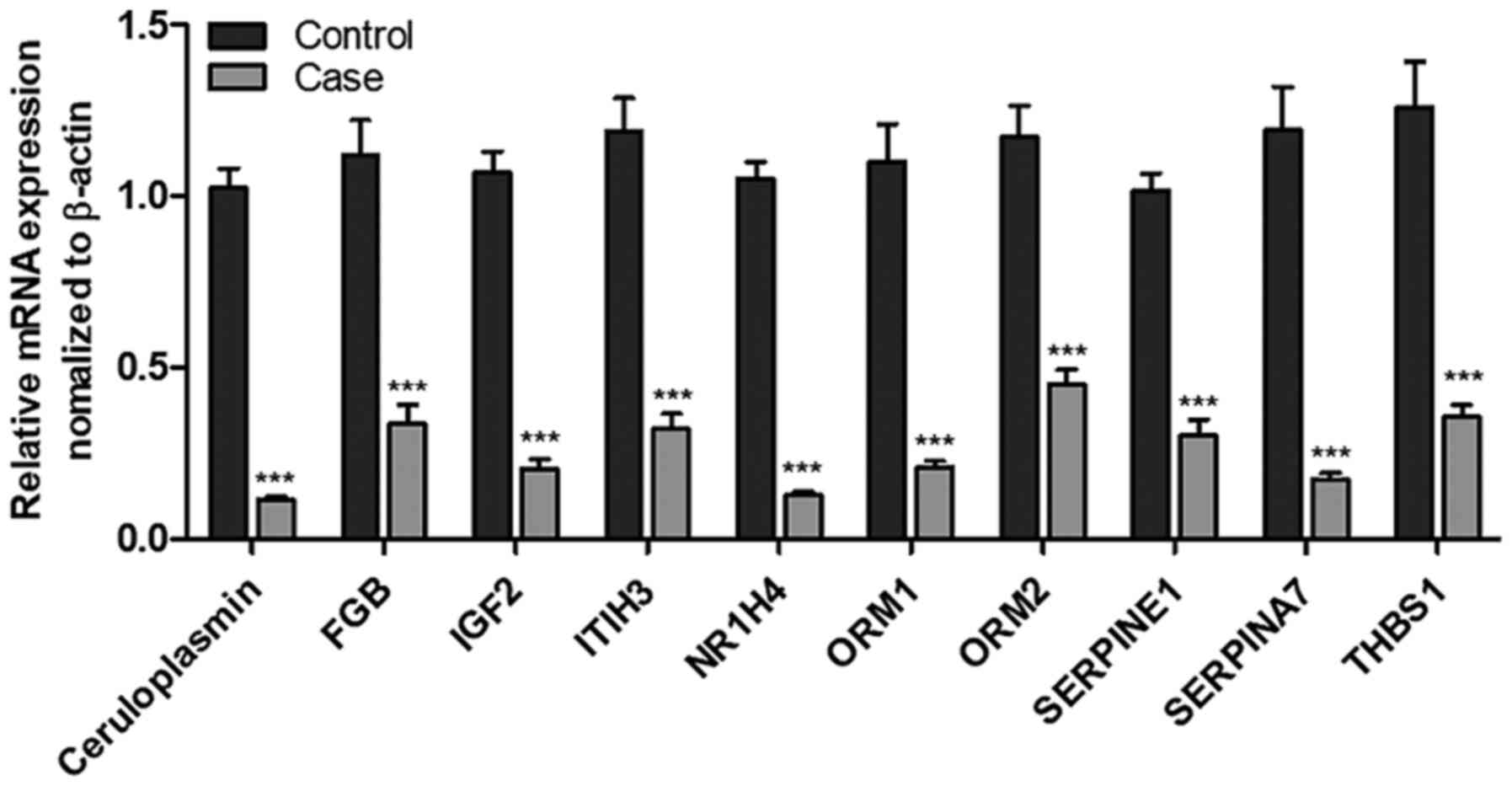|
1
|
Li J, Fu Y, Hu X and Xiong Y: Psoralidin
inhibits the proliferation of human liver cancer cells by
triggering cell cycle arrest, apoptosis and autophagy and inhibits
tumor growth in vivo. J BUON. 24:1950–1955. 2019.PubMed/NCBI
|
|
2
|
Sakin A, Sahin S, Atci MM, Yasar N,
Geredeli C, Aribal S, Alemdar A, Karataş F and Cihan S: Factors
affecting survival in patients with isolated liver-metastatic
colorectal cancer treated with local ablative or surgical
treatments for liver metastasis. J BUON. 24:1801–1808.
2019.PubMed/NCBI
|
|
3
|
Zhang X, Lv J, Luo H, Liu Z, Xu C, Zhou D,
Tang L, Zhang Z, Liu J, Xiao M, et al: Nucleostemin promotes
hepatocellular carcinoma by regulating the function of STAT3. Exp
Cell Res. 387:1117482020. View Article : Google Scholar : PubMed/NCBI
|
|
4
|
Xu L, Wang R, Ziegelbauer J, Wu WW, Shen
RF, Juhl H, Zhang Y, Pelosof L and Rosenberg AS: Transcriptome
analysis of human colorectal cancer biopsies reveals extensive
expression correlations among genes related to cell proliferation,
lipid metabolism, immune response and collagen catabolism.
Oncotarget. 8:74703–74719. 2017. View Article : Google Scholar : PubMed/NCBI
|
|
5
|
Xu Y, Lv X, Yang G, Zhan J, Li M, Long T,
Ho CT and Li S: Simultaneous separation of six pure
polymethoxyflavones from sweet orange peel extract by high
performance counter current chromatography. Food Chem. 292:160–165.
2019. View Article : Google Scholar : PubMed/NCBI
|
|
6
|
Kang SI, Shin HS and Kim SJ: Sinensetin
enhances adipogenesis and lipolysis by increasing cyclic adenosine
monophosphate levels in 3T3-L1 adipocytes. Biol Pharm Bull.
38:552–558. 2015. View Article : Google Scholar : PubMed/NCBI
|
|
7
|
Yu T, Zhang H and Qi H: Transcriptome
profiling analysis reveals biomarkers in colon cancer samples of
various differentiation. Oncol Lett. 16:48–54. 2018.PubMed/NCBI
|
|
8
|
Luo J, Dai X, Hu H, Chen J, Zhao L, Yang
C, Sun J, Zhang L, Wang Q, Xu S, et al: Fluzoparib increases
radiation sensitivity of non-small cell lung cancer (NSCLC) cells
without BRCA1/2 mutation, a novel PARP1 inhibitor undergoing
clinical trials. J Cancer Res Clin Oncol. 146:721–737. 2020.
View Article : Google Scholar : PubMed/NCBI
|
|
9
|
Lin KH, Huang MY, Cheng WC, Wang SC, Fang
SH, Tu HP, Su CC, Hung YL, Liu PL, Chen CS, et al: RNA-seq
transcriptome analysis of breast cancer cell lines under shikonin
treatment. Sci Rep. 8:26722018. View Article : Google Scholar : PubMed/NCBI
|
|
10
|
Wang D, Zhao L, Wang D, Liu J, Yu X, Wei Y
and Ouyang Z: Transcriptome analysis and identification of key
genes involved in 1-deoxynojirimycin biosynthesis of mulberry
(Morus alba L.). PeerJ. 6:e54432018. View Article : Google Scholar : PubMed/NCBI
|
|
11
|
Zhang Y, Kang Z, Lv D, Zhang X, Liao Y, Li
Y, Liu R, Li P, Tong M, Tian J, et al: Longitudinal whole-genome
sequencing reveals the evolution of MPAL. Cancer Genet. 240:59–65.
2020. View Article : Google Scholar : PubMed/NCBI
|
|
12
|
Niemira M, Collin F, Szalkowska A, Bielska
A, Chwialkowska K, Reszec J, Niklinski J, Kwasniewski M and
Kretowski A: Molecular signature of subtypes of non-small-cell lung
cancer by large-scale transcriptional profiling: Identification of
key modules and genes by Weighted Gene Co-Expression Network
Analysis (WGCNA). Cancers (Basel). 12:E372019. View Article : Google Scholar : PubMed/NCBI
|
|
13
|
Wang Z, Zhang Z, Zhang C and Xu Y:
Identification of potential pathogenic biomarkers in clear cell
renal cell carcinoma. Oncol Lett. 15:8491–8499. 2018.PubMed/NCBI
|
|
14
|
Stark R, Grzelak M and Hadfield J: RNA
sequencing: The teenage years. Nat Rev Genet. 20:631–656. 2019.
View Article : Google Scholar : PubMed/NCBI
|
|
15
|
Liu Y, Gu HY, Zhu J, Niu YM, Zhang C and
Guo GL: Identification of hub genes and key pathways associated
with bipolar disorder based on weighted gene co-expression Network
Analysis. Front Physiol. 10:10812019. View Article : Google Scholar : PubMed/NCBI
|
|
16
|
Trapnell C, Pachter L and Salzberg SL:
TopHat: Discovering splice junctions with RNA-Seq. Bioinformatics.
25:1105–1111. 2009. View Article : Google Scholar : PubMed/NCBI
|
|
17
|
Trapnell C, Williams BA, Pertea G,
Mortazavi A, Kwan G, van Baren MJ, Salzberg SL, Wold BJ and Pachter
L: Transcript assembly and quantification by RNA-Seq reveals
unannotated transcripts and isoform switching during cell
differentiation. Nat Biotechnol. 28:511–515. 2010. View Article : Google Scholar : PubMed/NCBI
|
|
18
|
Benjamini Y, Drai D, Elmer G, Kafkafi N
and Golani I: Controlling the false discovery rate in behavior
genetics research. Behav Brain Res. 125:279–284. 2001. View Article : Google Scholar : PubMed/NCBI
|
|
19
|
Szklarczyk D, Gable AL, Lyon D, Junge A,
Wyder S, Huerta-Cepas J, Simonovic M, Doncheva NT, Morris JH, Bork
P, et al: STRING v11: Protein-protein association networks with
increased coverage, supporting functional discovery in genome-wide
experimental datasets. Nucleic Acids Res. 47:D607–D613. 2019.
View Article : Google Scholar : PubMed/NCBI
|
|
20
|
Shannon P, Markiel A, Ozier O, Baliga NS,
Wang JT, Ramage D, Amin N, Schwikowski B and Ideker T: Cytoscape: A
software environment for integrated models of biomolecular
interaction networks. Genome Res. 13:2498–2504. 2003. View Article : Google Scholar : PubMed/NCBI
|
|
21
|
Supek F, Bošnjak M, Škunca N and Šmuc T:
REVIGO summarizes and visualizes long lists of gene ontology terms.
PLoS One. 6:e218002011. View Article : Google Scholar : PubMed/NCBI
|
|
22
|
Kim SM, Ha SE, Ho JL, Rampogu S, Vetrivel
P, Kim HH, Saralamma VVG, Lee KW and Kim GS: Sinensetin Induces
Autophagic Cell Death through p53-Related AMPK/mTOR Signaling in
Hepatocellular Carcinoma HepG2 Cells. Nutrients. 12:24622020.
View Article : Google Scholar
|
|
23
|
Xiong H, Guo H, Xie Y, Zhao L, Gu J, Zhao
S, Li J and Liu L: RNAseq analysis reveals pathways and candidate
genes associated with salinity tolerance in a spaceflight-induced
wheat mutant. Sci Rep. 7:27312017. View Article : Google Scholar : PubMed/NCBI
|
|
24
|
Livingstone C: IGF2 and cancer. Endocr
Relat Cancer. 20:R321–R339. 2013. View Article : Google Scholar : PubMed/NCBI
|
|
25
|
Macaulay VM: Insulin-like growth factors
and cancer. Br J Cancer. 65:311–320. 1992. View Article : Google Scholar : PubMed/NCBI
|
|
26
|
Guerra FK, Eijan AM, Puricelli L, Alonso
DF, Bal de Kier Joffé E, Kornblihgtt AR, Charreau EH and Elizalde
PV: Varying patterns of expression of insulin-like growth factors I
and II and their receptors in murine mammary adenocarcinomas of
different metastasizing ability. Int J Cancer. 65:812–820. 1996.
View Article : Google Scholar : PubMed/NCBI
|
|
27
|
Lin SB, Hsieh SH, Hsu HL, Lai MY, Kan LS
and Au LC: Antisense oligodeoxynucleotides of IGF-II selectively
inhibit growth of human hepatoma cells overproducing IGF-II. J
Biochem. 122:717–722. 1997. View Article : Google Scholar : PubMed/NCBI
|
|
28
|
Martinez-Quetglas I, Pinyol R, Dauch D,
Torrecilla S, Tovar V, Moeini A, Alsinet C, Portela A,
Rodriguez-Carunchio L, Solé M, et al: IGF2 Is up-regulated by
epigenetic mechanisms in hepatocellular carcinomas and is an
actionable oncogene product in experimental models.
Gastroenterology. 151:1192–1205. 2016. View Article : Google Scholar : PubMed/NCBI
|
|
29
|
Andreasen PA, Kjøller L, Christensen L and
Duffy MJ: The urokinase-type plasminogen activator system in cancer
metastasis: A review. Int J Cancer. 72:1–22. 1997. View Article : Google Scholar : PubMed/NCBI
|
|
30
|
Hundsdorfer B, Zeilhofer HF, Bock KP,
Dettmar P, Schmitt M and Horch HH: The prognostic importance of
urinase type plasminogen activators (uPA) and plasminogen activator
inhibitors (PAI-1) in the primary resection of oral squamous cell
carcinoma. Mund Kiefer Gesichtschir. 8:173–179. 2004.(In German).
PubMed/NCBI
|
|
31
|
Annecke K, Schmitt M, Euler U, Zerm M,
Paepke D, Paepke S, von Minckwitz G, Thomssen C and Harbeck N: uPA
and PAI-1 in breast cancer: Review of their clinical utility and
current validation in the prospective NNBC-3 trial. Adv Clin Chem.
45:31–45. 2008. View Article : Google Scholar : PubMed/NCBI
|
|
32
|
Harbeck N, Schmitt M, Paepke S, Allgayer H
and Kates RE: Tumor-associated proteolytic factors uPA and PAI-1:
Critical appraisal of their clinical relevance in breast cancer and
their integration into decision-support algorithms. Crit Rev Clin
Lab Sci. 44:179–201. 2007. View Article : Google Scholar : PubMed/NCBI
|
|
33
|
Vairaktaris E, Yapijakis C, Psyrri A,
Spyridonidou S, Yannopoulos A, Lazaris A, Vassiliou S, Ferekidis E,
Vylliotis A, Nkenke E, et al: Loss of tumour suppressor p16
expression in initial stages of oral oncogenesis. Anticancer Res.
27:979–984. 2007.PubMed/NCBI
|
|
34
|
Li L, Zhu Z, Zhao Y, Zhang Q, Wu X, Miao
B, Cao J and Fei S: FN1, SPARC, and SERPINE1 are highly expressed
and significantly related to a poor prognosis of gastric
adenocarcinoma revealed by microarray and bioinformatics. Sci Rep.
9:78272019. View Article : Google Scholar : PubMed/NCBI
|
|
35
|
Yu XM, Jaskula-Sztul R, Georgen MR,
Aburjania Z, Somnay YR, Leverson G, Sippel RS, Lloyd RV, Johnson BP
and Chen H: Notch1 signaling regulates the aggressiveness of
differentiated thyroid cancer and inhibits SERPINE1 expression.
Clin Cancer Res. 22:3582–3592. 2016. View Article : Google Scholar : PubMed/NCBI
|
|
36
|
Zheng Q, Tang ZY, Xue Q, Shi DR, Song HY
and Tang HB: Invasion and metastasis of hepatocellular carcinoma in
relation to urokinase-type plasminogen activator, its receptor and
inhibitor. J Cancer Res Clin Oncol. 126:641–646. 2000. View Article : Google Scholar : PubMed/NCBI
|
|
37
|
Divella R, Mazzocca A, Gadaleta C, Simone
G, Paradiso A, Quaranta M and Daniele A: Influence of plasminogen
activator inhibitor-1 (SERPINE1) 4G/5G polymorphism on circulating
SERPINE-1 antigen expression in HCC associated with viral
infection. Cancer Genomics Proteomics. 9:193–198. 2012.PubMed/NCBI
|
|
38
|
Holm M, Saraswat M, Joenväärä S, Ristimäki
A, Haglund C and Renkonen R: Colorectal cancer patients with
different C-reactive protein levels and 5-year survival times can
be differentiated with quantitative serum proteomics. PLoS One.
13:e01953542018. View Article : Google Scholar : PubMed/NCBI
|
|
39
|
Berger HR, Creech MK, Hannoush Z, Watanabe
Y, Kargi A and Weiss RE: A novel mutation causing complete thyroid
binding globulin deficiency (Tbg-Cd Mia) in a male with coexisting
graves disease. AACE Clin Case Rep. 3:e134–e139. 2017. View Article : Google Scholar : PubMed/NCBI
|
|
40
|
Falanga A, Marchetti M and Vignoli A:
Coagulation and cancer: Biological and clinical aspects. J Thromb
Haemost. 11:223–233. 2013. View Article : Google Scholar : PubMed/NCBI
|
|
41
|
Adams GN, Rosenfeldt L, Frederick M,
Miller W, Waltz D, Kombrinck K, McElhinney KE, Flick MJ, Monia BP,
Revenko AS, et al: Colon cancer growth and dissemination relies
upon thrombin, stromal PAR-1, and fibrinogen. Cancer Res.
75:4235–4243. 2015. View Article : Google Scholar : PubMed/NCBI
|
|
42
|
Ciereszko A, Dietrich MA, Słowińska M,
Nynca J, Ciborowski M, Kisluk J, Michalska-Falkowska A, Reszec J,
Sierko E and Nikliński J: Identification of protein changes in the
blood plasma of lung cancer patients subjected to chemotherapy
using a 2D-DIGE approach. PLoS One. 14:e02238402019. View Article : Google Scholar : PubMed/NCBI
|
|
43
|
Dowling P, Palmerini V, Henry M, Meleady
P, Lynch V, Ballot J, Gullo G, Crown J, Moriarty M and Clynes M:
Transferrin-bound proteins as potential biomarkers for advanced
breast cancer patients. BBA Clin. 2:24–30. 2014. View Article : Google Scholar : PubMed/NCBI
|
|
44
|
Zhang X, Wang F, Huang Y, Ke K, Zhao B,
Chen L, Liao N, Wang L, Li Q, Liu X, et al: FGG promotes migration
and invasion in hepatocellular carcinoma cells through activating
epithelial to mesenchymal transition. Cancer Manag Res.
11:1653–1665. 2019. View Article : Google Scholar : PubMed/NCBI
|
|
45
|
Lee YS, Choi JW, Hwang I, Lee JW, Lee JH,
Kim AY, Huh JY, Koh YJ, Koh GY, Son HJ, et al: Adipocytokine
orosomucoid integrates inflammatory and metabolic signals to
preserve energy homeostasis by resolving immoderate inflammation. J
Biol Chem. 285:22174–22185. 2010. View Article : Google Scholar : PubMed/NCBI
|
|
46
|
Li F, Yu Z, Chen P, Lin G, Li T, Hou L, Du
Y and Tan W: The increased excretion of urinary orosomucoid 1 as a
useful biomarker for bladder cancer. Am J Cancer Res. 6:331–340.
2016.PubMed/NCBI
|
|
47
|
Ayyub A, Saleem M, Fatima I, Tariq A,
Hashmi N and Musharraf SG: Glycosylated alpha-1-acid glycoprotein 1
as a potential lung cancer serum biomarker. Int J Biochem Cell
Biol. 70:68–75. 2016. View Article : Google Scholar : PubMed/NCBI
|
|
48
|
Rucksaken R, Charoensuk L, Pinlaor P,
Pairojkul C, Khuntikeo N and Pinlaor S: Plasma orosomucoid 2 as a
potential risk marker of cholangiocarcinoma. Cancer Biomark.
18:27–34. 2017. View Article : Google Scholar : PubMed/NCBI
|
|
49
|
Falleti E, Pirisi M, Fabris C, Bortolotti
N, Soardo G, Toniutto P, Gonano F and Bartoli E: Increase of serum
alpha 1-acid glycoprotein despite the decline of liver synthetic
function in cirrhotics with hepatocellular carcinoma. Eur J Clin
Chem Clin Biochem. 31:407–411. 1993.PubMed/NCBI
|
|
50
|
Alexander H, Stegner AL, Wagner-Mann C, Du
Bois GC, Alexander S and Sauter ER: Proteomic analysis to identify
breast cancer biomarkers in nipple aspirate fluid. Clin Cancer Res.
10:7500–7510. 2004. View Article : Google Scholar : PubMed/NCBI
|
|
51
|
Forman BM, Goode E, Chen J, Oro AE,
Bradley DJ, Perlmann T, Noonan DJ, Burka LT, McMorris T, Lamph WW,
et al: Identification of a nuclear receptor that is activated by
farnesol metabolites. Cell. 81:687–693. 1995. View Article : Google Scholar : PubMed/NCBI
|
|
52
|
Sinal CJ, Tohkin M, Miyata M, Ward JM,
Lambert G and Gonzalez FJ: Targeted disruption of the nuclear
receptor FXR/BAR impairs bile acid and lipid homeostasis. Cell.
102:731–744. 2000. View Article : Google Scholar : PubMed/NCBI
|
|
53
|
Lu TT, Makishima M, Repa JJ, Schoonjans K,
Kerr TA, Auwerx J and Mangelsdorf DJ: Molecular basis for feedback
regulation of bile acid synthesis by nuclear receptors. Mol Cell.
6:507–515. 2000. View Article : Google Scholar : PubMed/NCBI
|
|
54
|
You W, Chen B, Liu X, Xue S, Qin H and
Jiang H: Farnesoid X receptor, a novel proto-oncogene in non-small
cell lung cancer, promotes tumor growth via directly
transactivating CCND1. Sci Rep. 7:5912017. View Article : Google Scholar : PubMed/NCBI
|
|
55
|
Guan B, Li H, Yang Z, Hoque A and Xu X:
Inhibition of farnesoid X receptor controls esophageal cancer cell
growth in vitro and in nude mouse xenografts. Cancer.
119:1321–1329. 2013. View Article : Google Scholar : PubMed/NCBI
|
|
56
|
Guo F, Xu Z, Zhang Y, Jiang P, Huang G,
Chen S, Lyu X, Zheng P, Zhao X, Zeng Y, et al: FXR induces SOCS3
and suppresses hepatocellular carcinoma. Oncotarget. 6:34606–34616.
2015. View Article : Google Scholar : PubMed/NCBI
|
|
57
|
Adams JC and Lawler J: The
thrombospondins. Int J Biochem Cell Biol. 36:961–968. 2004.
View Article : Google Scholar : PubMed/NCBI
|
|
58
|
Huang T, Wang L, Liu D, Li P, Xiong H,
Zhuang L, Sun L, Yuan X and Qiu H: FGF7/FGFR2 signal promotes
invasion and migration in human gastric cancer through upregulation
of thrombospondin-1. Int J Oncol. 50:1501–1512. 2017. View Article : Google Scholar : PubMed/NCBI
|
|
59
|
Firlej V, Mathieu JR, Gilbert C, Lemonnier
L, Nakhlé J, Gallou-Kabani C, Guarmit B, Morin A, Prevarskaya N,
Delongchamps NB, et al: Thrombospondin-1 triggers cell migration
and development of advanced prostate tumors. Cancer Res.
71:7649–7658. 2011. View Article : Google Scholar : PubMed/NCBI
|
|
60
|
Perez-Janices N, Blanco-Luquin I, Tuñón
MT, Barba-Ramos E, Ibáñez B, Zazpe-Cenoz I, Martinez-Aguillo M,
Hernandez B, Martínez-Lopez E, Fernández AF, et al: EPB41L3, TSP-1
and RASSF2 as new clinically relevant prognostic biomarkers in
diffuse gliomas. Oncotarget. 6:368–380. 2015. View Article : Google Scholar : PubMed/NCBI
|
|
61
|
Nie S, Lo A, Wu J, Zhu J, Tan Z, Simeone
DM, Anderson MA, Shedden KA, Ruffin MT and Lubman DM: Glycoprotein
biomarker panel for pancreatic cancer discovered by quantitative
proteomics analysis. J Proteome Res. 13:1873–1884. 2014. View Article : Google Scholar : PubMed/NCBI
|
|
62
|
Lyu T, Jia N, Wang J, Yan X, Yu Y, Lu Z,
Bast RC Jr, Hua K and Feng W: Expression and epigenetic regulation
of angiogenesis-related factors during dormancy and recurrent
growth of ovarian carcinoma. Epigenetics. 8:1330–1346. 2013.
View Article : Google Scholar : PubMed/NCBI
|
|
63
|
Poon RT, Chung KK, Cheung ST, Lau CP, Tong
SW, Leung KL, Yu WC, Tuszynski GP and Fan ST: Clinical significance
of thrombospondin 1 expression in hepatocellular carcinoma. Clin
Cancer Res. 10:4150–4157. 2004. View Article : Google Scholar : PubMed/NCBI
|
|
64
|
Hayashi K, Kurohiji T and Shirouzu K:
Localization of thrombospondin in hepatocellular carcinoma.
Hepatology. 25:569–574. 1997. View Article : Google Scholar : PubMed/NCBI
|
|
65
|
Lee TK, Cheung VC, Lu P, Lau EY, Ma S,
Tang KH, Tong M, Lo J and Ng IO: Blockade of CD47-mediated
cathepsin S/protease-activated receptor 2 signaling provides a
therapeutic target for hepatocellular carcinoma. Hepatology.
60:179–191. 2014. View Article : Google Scholar : PubMed/NCBI
|
|
66
|
Tórsdóttir G, Gudmundsson G, Kristinsson
J, Snaedal J and Jóhannesson T: Ceruloplasmin and superoxide
dismutase (SOD1) in heterozygotes for Wilson disease: A case
control study. Neuropsychiatr Dis Treat. 5:55–59. 2009. View Article : Google Scholar : PubMed/NCBI
|
|
67
|
Schapira DV and Schapira M: Use of
ceruloplasmin levels to monitor response to therapy and predict
recurrence of breast cancer. Breast Cancer Res Treat. 3:221–224.
1983. View Article : Google Scholar : PubMed/NCBI
|
|
68
|
Brandi J, Dalla Pozza E, Dando I, Biondani
G, Robotti E, Jenkins R, Elliott V, Park K, Marengo E, Costello E,
et al: Secretome protein signature of human pancreatic cancer
stem-like cells. J Proteomics. 136:1–12. 2016. View Article : Google Scholar : PubMed/NCBI
|
|
69
|
Han IW, Jang JY, Kwon W, Park T, Kim Y,
Lee KB and Kim SW: Ceruloplasmin as a prognostic marker in patients
with bile duct cancer. Oncotarget. 8:29028–29037. 2017. View Article : Google Scholar : PubMed/NCBI
|
|
70
|
Upadhya S, Upadhya S and Prabhu KS: Serum
glycoconjugates and ceruloplasmin in cancer of uterine cervix.
Indian J Clin Biochem. 17:20–24. 2002. View Article : Google Scholar : PubMed/NCBI
|
|
71
|
Arumanayagam M, Wong FW, Rogers M and
Swaminathan R: Serum ceruloplasmin, plasma copper concentration and
copper to ceruloplasmin ratio in cervical carcinoma. Gynecol Obstet
Invest. 35:175–178. 1993. View Article : Google Scholar : PubMed/NCBI
|
|
72
|
Huang L, Yoneda M and Kimata K: A
serum-derived hyaluronan-associated protein (SHAP) is the heavy
chain of the inter alpha-trypsin inhibitor. J Biol Chem.
268:26725–26730. 1993. View Article : Google Scholar : PubMed/NCBI
|
|
73
|
Chatterji B and Borlak J: A 2-DE MALDI-TOF
study to identify disease regulated serum proteins in lung cancer
of c-myc transgenic mice. Proteomics. 9:1044–1056. 2009. View Article : Google Scholar : PubMed/NCBI
|
|
74
|
Heo SH, Lee SJ, Ryoo HM, Park JY and Cho
JY: Identification of putative serum glycoprotein biomarkers for
human lung adenocarcinoma by multilectin affinity chromatography
and LC-MS/MS. Proteomics. 7:4292–4302. 2007. View Article : Google Scholar : PubMed/NCBI
|
|
75
|
Chong PK, Lee H, Zhou J, Liu SC, Loh MC,
Wang TT, Chan SP, Smoot DT, Ashktorab H, So JB, et al: ITIH3 is a
potential biomarker for early detection of gastric cancer. J
Proteome Res. 9:3671–3679. 2010. View Article : Google Scholar : PubMed/NCBI
|
|
76
|
Pertea M: The human transcriptome: An
unfinished story. Genes (Basel). 3:344–360. 2012. View Article : Google Scholar : PubMed/NCBI
|
|
77
|
Cajigas-Du Ross CK, Martinez SR,
Woods-Burnham L, Durán AM, Roy S, Basu A, Ramirez JA,
Ortiz-Hernández GL, Ríos-Colón L, Chirshev E, et al: RNA sequencing
reveals upregulation of a transcriptomic program associated with
stemness in metastatic prostate cancer cells selected for taxane
resistance. Oncotarget. 9:30363–30384. 2018. View Article : Google Scholar : PubMed/NCBI
|
|
78
|
Zhao S, Fung-Leung WP, Bittner A, Ngo K
and Liu X: Comparison of RNA-Seq and microarray in transcriptome
profiling of activated T cells. PLoS One. 9:e786442014. View Article : Google Scholar : PubMed/NCBI
|
|
79
|
Zhang Z, Li B, Xu P and Yang B: Integrated
whole transcriptome profiling and bioinformatics analysis for
revealing regulatory pathways associated with quercetin-induced
apoptosis in HCT-116 cells. Front Pharmacol. 10:7982019. View Article : Google Scholar : PubMed/NCBI
|
|
80
|
Xiong YJ, Deng ZB, Liu JN, Qiu JJ, Guo L,
Feng PP, Sui JR, Chen DP and Guo HS: Enhancement of epithelial cell
autophagy induced by sinensetin alleviates epithelial barrier
dysfunction in colitis. Pharmacol Res. 148:1044612019. View Article : Google Scholar : PubMed/NCBI
|
|
81
|
Forni C, Facchiano F, Bartoli M, Pieretti
S, Facchiano A, D'Arcangelo D, Norelli S, Valle G, Nisini R,
Beninati S, et al: Beneficial role of phytochemicals on oxidative
stress and age-related diseases. BioMed Res Int. 2019:87482532019.
View Article : Google Scholar : PubMed/NCBI
|


















